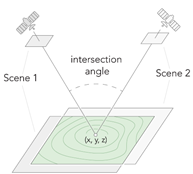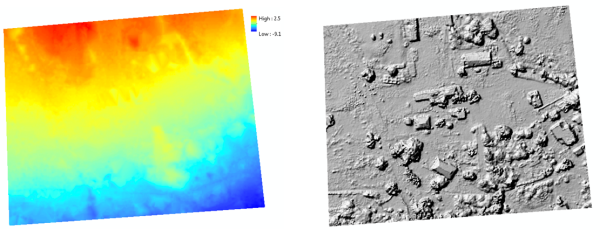Available with Advanced license.
Elevation data can be derived from stereo image pairs using photogrammetry algorithms. A stereo pair is composed of two images of the same geolocation taken from different perspectives.

The stereo image pairs of an image collection are used to generate a point cloud (3D points) from which elevation data can be derived. The derived elevation data will be used to orthorectify the image collection in the ortho mapping workspace.
Note:
Nadir (vertical) viewing, high-resolution satellite imagery is not affected much by distortion that is inherent in aerial imagery due to the large distance between sensor and ground, long sensor focal length (typically 10 meters), and small field of view. These factors, together with accurate orientation information in the form of rational polynomial coefficients (RPCs), result in the condition that DEM accuracy and dense postings are less important in producing accurate orthoimages, as long as the adjusted exterior orientation and control points are adequate. The DEM generation step is often not used, and existing USGS NED DEMs or SRTM DEMs, together with accurate GCPs, can produce Class I or Class II orthoimages at a scale of 1:5,000 or smaller.
The 3D points generated from stereo pairs in the DEMs wizard are classified into two categories:
- Digital terrain model (DTM)—The digital elevation of the earth, not including the elevation of any objects on it. This is also referred to as bare-earth elevation. The bare earth DTM dataset is used to produce the orthoimage and orthomosaics.
- Digital surface model (DSM)—The digital elevation of the earth, including the elevation of objects on it such as trees and buildings. The DSM is a valuable analytical dataset used for classifying features in orthoimages, such as discriminating asphalt pavement and asphalt roofs. It should not be used for image orthorectification unless the source imagery is nadir looking, with no building or feature lean, to produce true orthoimages.

Note:
If a forest area is heavily wooded, or has other dense vegetation cover, it will not be possible to derive a DTM ground surface because the ground is not visible. The most appropriate elevation surface product for densely forested land cover is a DSM, which specifically creates a surface depicting the top of the tree canopy.
Elevation can be derived when the image collection has a good amount of overlap to form the stereo pairs. Typical image overlap to produce point clouds is 80 percent forward overlap along a flight line and 60 percent overlap between flight lines, so that every location on the ground is covered by multiple images. It is often used in processing drone images, digital aerial images, or certain satellite images captured specifically for stereo applications.
This wizard provides two preconfigured steps to produce the outputs:
- Construct stereo pairs from the image collection to compute the point cloud.
- Interpolate a raster at a user-defined resolution from the point cloud.
You can modify the default processing parameters, but you cannot remove a step. To omit or perform a specific step, use the Custom wizard.
Point Cloud Settings page
Specify parameter values on the Point Cloud Settings page.
Parameters for Point Cloud Settings
| Parameter | Description |
|---|---|
Matching Method | Specifies the matching method that will be used to generate a point cloud:
|
Maximum Object Size (in meters) | A search radius that is used to filter out objects above ground. Objects smaller than the threshold will be filtered as ground; otherwise, objects will be treated as above-ground features such as buildings, bridges, or trees. The default object size is 10 meters. |
Point Ground Spacing | The spacing, in meters, at which the 3D points are generated. The suggested spacing is five times the source image pixel size. |
Minimum Intersection Angle (in degrees) | The point cloud is generated from stereo pairs. This value, in degrees, defines the minimum angle the stereo pair must meet. The default is 5 degrees. A stereo pair with an intersection angle that is too small will produce unstable results when triangulating 3D points. |
Maximum Intersection Angle (in degrees) | The point cloud is generated from stereo pairs. This value, in degrees, defines the maximum angle the stereo pair must meet. The default is 70 degrees. A stereo pair with an intersection angle that is too large will produce few or no match points. |
Minimum Area Overlap | The percentage of overlapping area over the whole image. The default is 0.6. |
Maximum Omega/Phi Difference (in degrees) |
The maximum threshold for the Omega and Phi difference between the two image pairs. The Omega values and Phi values for the image pairs are compared. If the difference between either the two Omega or the two Phi values is above the threshold, the pairs will not be formatted as a stereo pair. |
Maximum GSD Difference | The threshold for the maximum ground sample distance (GSD) between two images in a stereo pair. If the resolution ratio between the two images is greater than the threshold value, the pairs will not be built as a stereo pair. The default is 2. |
Number of Image Pairs | The number of pairs used to generate 3D points. For a project that has dense overlaps and many stereo pairs, increasing this number means more computation time. The suggested value is 8. Sometimes a location may be covered with many image pairs. In this case, the pairs will be ordered based on the various threshold parameters specified in this tool. The pairs with the highest scores will be used to generate the points. This parameter limits one pair from being used too many times. The parameters that affect the order of the stereo pair, in addition to Minimum Intersection Angle, Maximum Intersection Angle, and Minimum Area Overlap, can also include Maximum Omega/Phi Difference, Maximum GSD Difference, and Adjustment Quality Threshold. |
Adjustment Quality Threshold | The minimum adjustment quality that is acceptable. The threshold value will be compared to the adjustment quality value that is stored in the stereo model. Image pairs with an adjustment quality less than the specified threshold will receive a score of 0 for this criteria and will descend in the ordered list. The values for the threshold ranges from 0 to 1. The suggested value is 0.2. |
References
- Harris, Christopher G., and Mike Stephens. "A combined corner and edge detector." Alvey vision conference, vol. 15, no. 50, pp. 10-5244. 1988.
- Hirschmuller, Heiko, Maximilian Buder, and Ines Ernst. "Memory Efficient Semi-Global Matching." ISPRS Annals of the Photogrammetry, Remote Sensing and Spatial Information Sciences, Volume 1-3, (2012): 371-376.
- Hirschmuller, Heiko. "Stereo Processing by Semiglobal Matching and Mutual Information." IEEE Transactions on pattern analysis and machine intelligence, Volume 30, no. 2 (2007): 328-341.
DEM Interpolation Settings page
Specify the parameter values on the DEM Interpolation Settings page.
Parameters for DEM Interpolation Settings
| Parameter name | Description |
|---|---|
Surface Type | Specifies the surface type for a digital terrain model or a digital surface model.
|
Cellsize | The cell size of the output raster dataset. |
Format | Specifies the format for the output raster dataset:
|
Compression | Specifies the compression method for the output raster dataset.
|
Max Error | The maximum error allowed for LERC compression. The maximum error is a tolerance value that is applicable per pixel (not an average for the image). Set the Compression parameter to LERC to use this parameter. |
Interpolation Method | Specifies the method that will be used to interpolate the output raster dataset from the point cloud.
|
Smoothing Method | Specifies the filter that will be used to smooth the output raster dataset.
|
Fill Missing Pixels Using | A DEM input that is used to fill NoData areas. Areas of NoData may exist where stereo overlap is insufficient or no matching points are found in the area during point cloud generation. |